Networked Objects Journal
Shawn Van Every (sve204 at nyu dot edu), Spring 2003
May 4, 2003
Final Project
Seeing, Talking Rhino
For my final project I created a seeing, talking rhino. It is a stuffed animal that has a camera, ethernet controller and voice synthesis module embeded with in it for the purpose of creating a hybrid telepresence and survellance object.



Java Applet/Application (requires Java 1.2 or greater including the Java browser plugin).
Source code
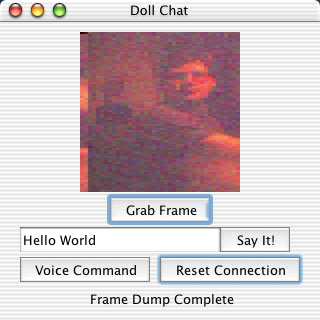
Better Screen Shots and Video Footage to Come...
Component Information:
CMUCam purchased from Seattle Robotics and developed at CMU's Robotics Institute
V8600A Voice Synthesis Module from RC Systems
CoBox Micro from Lantronix
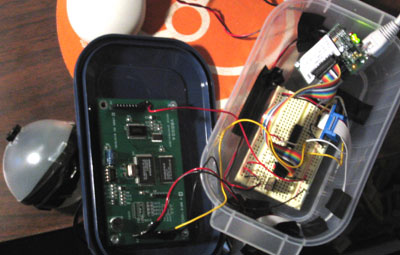
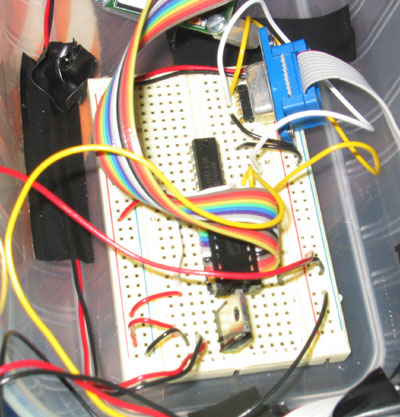
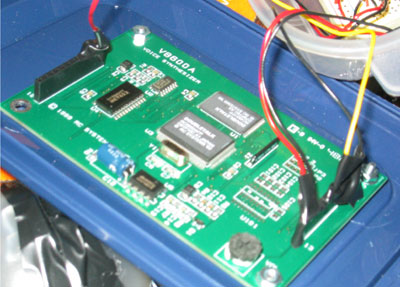
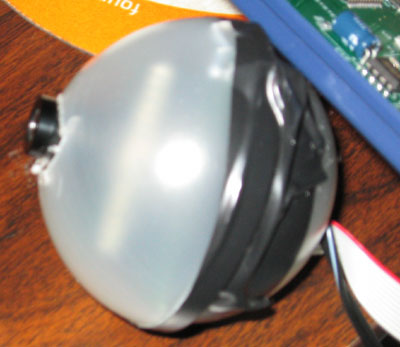
For this project, I did not utilize a microcontroller independent of the ones on the various modules (such as the one on the camera and the one on the voice synthesis module).
Summer Project Idea: Roaming DNS like Service for ITP Stage (for WiFi and Embedded Devices)
Specs to Come Soon!
Mid-Term Paper, Concerning "Smart Mob" Media.
...
One of my biggest concerns of late has been the well known consolidation of media interests into the hands of a few (the media oligarchy) which can be said to be almost promoted by legislation in our governments. It is in the possibilities of subverting these trends that I look forward to new technologies in the hopes that traditional media are unable to evolve fast enough to meet the challenge these technologies will pose to their power structures. If these technologies are developed and deployed at a fast enough pace then perhaps individuals may have enough time to have their voices heard in an unedited and unbiased manner.
...
Stupid Net-Trick
After a series of difficulties related to using the PIC for the first time, attempting to use C instead of Basic and working with the CoBox micro I finally got something working.
For this project, I created a simple Java Application that communicated through the network to a board with a PIC reading ADC values from a POT and communicating serially through the CoBox. Turning the POT and thereby changing the ADC readings triggered the Java application to change background colors.
While not very exciting this project allowed me to learn quite a bit regarding the PIC, CoBox and PIC C.
Misc. Links:
Microchip, makers of the PIC series or microcontrollers.
Tom Igoe's Site, lots of great resources
Lantronix, makers of the CoBox Micro and the new XPort (really cool new product)
The PIC List, high volume mailing list, everything PIC and every thing else, a great resource
DLink, makers of wireless ethernet streaming cameras
A Summary of Ubiquitous, Mobile, and Wearable Computing (1/22/03)
Reading Notes: Website Activity Monitoring (real time)-Visitor Awareness http://www10.org/cdrom/papers/425/
Establish a physical (ambient) relationship w/web visitors
Do back checking of website associated w/domain - They will be seen much as you are in a showroom
Notes from Bill Buxton Reading: http://www.billbuxton.com/sponges.html
A user's perception of something comes from the interface that something presents not from an understanding of what that something is.
So, redesigning the interface, the physical interface is to change the perception of the thing. A TV is still a TV embedded in gas pump but people will think of it as gas pump entertainment, not TV.
Overloaded functionality makes all functions equally useless. Multipurpse machines are stuck in one location and do not move to the kitchen for recipe information nor to the livingroom for movie watching.
Some images of a functional board with CoBox, PIC and PC


First working PIC C code (reference): program.c
Student Discount on CoBox Micro order given by: Symmetry Electronics
As of late, I have come across a number of articles describing a new flexible display technology being refered to as Organic Light Emitting Polymars (OLEPs or OLEDs).
Below is a compilation of some of those links:
http://www.cnn.com/2002/TECH/industry/12/14/organic.displays.ap/index.html
http://www.wired.com/wired/archive/11.01/start.html?pg=6
http://www.wired.com/wired/archive/11.01/start.html?pg=8
http://www.corante.com/personal/redir/14372.html
http://www.nytimes.com/2003/01/30/technology/circuits/30next.html?8cir
http://www.universaldisplay.com/